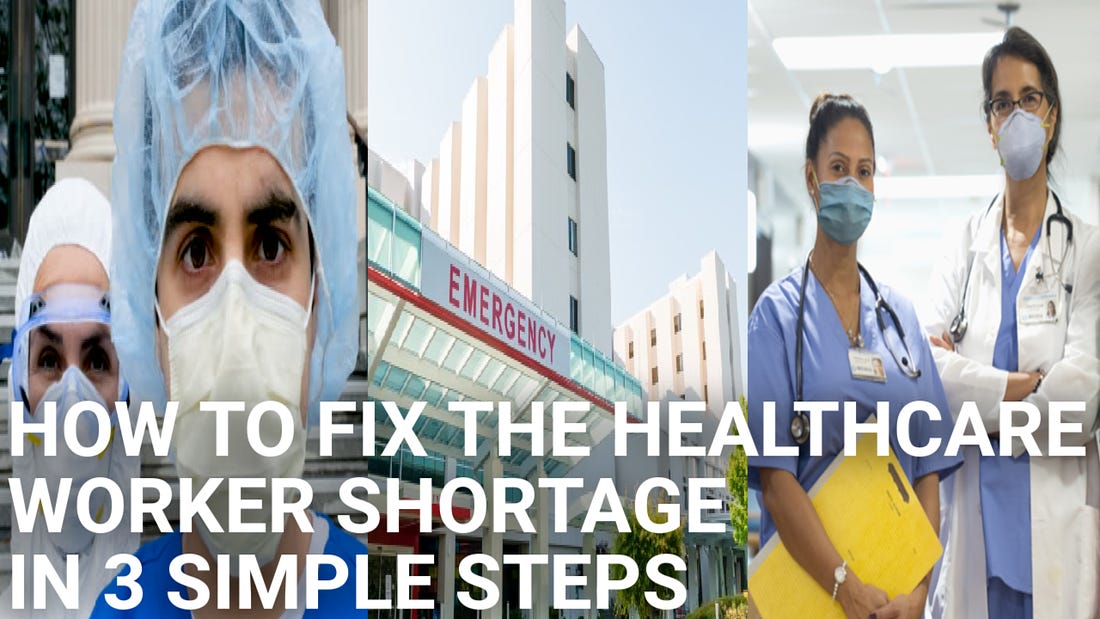Let’s be honest, the healthcare worker shortage was already a catastrophe before the pandemic. Nurses and doctors were already being offered triple the rate of pay through agencies, and offered other incentives to fill the void, yet shortages continued to grip the US medical system. That said, COVID-19 was the straw that broke the camel’s back for 3 major reasons: increased workload for workers, vaccine mandates, and asymptomatic testing. Those are the issues, this is how to fix them.
Before beginning, just so it’s clear, estimations by the Bureau of Labor Statistics reveal that nearly 20% of medical staff have intentionally quit the profession since the beginning of the pandemic, and those numbers have not been recovered. Those stats clearly show the underlying causative factors have not been addressed. Even so, medical administrators and agencies continue to incentivize with increased wages, while they ignore what’s really causing healthcare worker shortage. Anyways, let’s start with overstaffing.
The current workloads for nurses, and doctors are unrealistic, and unsustainable. For instance, the reported nursing burnout rate for RNs, and NPs is currently around 50% (see, here, here, and here). Nursing burnout rates are highly correlated with exiting the profession. To be specific, because the current nursing burn out rate is nearly 50%, 30% of those nurses surveyed will likely leave the profession and not return. As far as doctors, since the pandemic began, there’s a 4 times increase of physicians leaving the profession compared to before. Still, in light of monetary incentives dangled in front of nurses and doctors, they still choose to leave. Clearly, that is because money is not the sole issue. The problem is the physical and mental burden endured by our best and brightest. That happens because unrealistic patient loads increase mortality, and diminish quality of care, and our nurses and doctors have to stomach being the ones inadvertently doing harm as administrators fail to fix patient/medical staffing ratios. Such a heavy cross to bear for healthcare workers. The fix, medical facilities need to focus less on monetary incentives, and more on patient/worker ratios. It would be wise to create an internal team of staff that investigate areas of highest burnout. Then the team could work directly with affected RNs and MDs to brainstorm and implement new protocols to fix shortages. On top of that, routine internal audits of these special teams could be done to validate efficacy.
Next, COVID-19 vaccine mandates have certainly exacerbated the mass exit of nurses and doctors from the profession. Let’s not forget who was on the front lines when there was a shortage of PPE (personal protective equipment), and while no FDA EUA approved COVID treatments like monoclonal antibodies, vaccines, or antivirals were available. Anyways, as if the stress of poor staffing ratios wasn’t bad enough, infringement on the rights of well-to-do medical staff from vaccine mandates created another substantial stressor forcing them to leave. Sadly, while nurses and doctors historically have fought to ensure autonomy for patients, their’s ended up being ripped away. It is estimated that NYC lost nearly 34,000 healthcare workers since the implementation of vaccine mandates. Moreover, Kaiser Permanente, an enormous healthcare system took nearly 2,200 workers off payroll. The list goes on and on. The point is, there are tens of thousands of medical facilities in the USA losing essential workers in an already understaffed environment. Understand that hastening the shortage with mandates further increases patient mortality, and reduces the quality of care delivered in all medical settings. Are you ready to be that patient? Here’s how to fix it. Validate natural immunity and stop the mandates as vaccine efficacy against Omicron has substantially diminished. Most people in healthcare have already had exposure to the virus which confers durable natural immunity. Interestingly, Israeli data shows immunity after infection providing 13 times more protection than vaccination. Additionally, considering the high probably of repeat exposure, antibody levels of healthcare workers are likely higher than most, which makes them and the patients they treat among the most protected. That means, nurses and doctors who have had a positive RT-PCR test or that have robust antibody titers, should be considered supremely immune. Number two, new studies (here, here, and here) are showing Omicron to be highly transmissible but less severe in nature, while vaccine efficacy wanes. In other words, new data shows “53% reduced risk of any subsequent hospitalization, 53% reduced risk of symptomatic hospitalization, 74% reduced risk of ICU admission, and 91% reduced risk of death with Omicron compared to Delta” even while current vaccines are not reducing transmission, or severity of symptoms from the new variant. It’s time to validate natural immunity and get rid of the vaccine mandate so our best and brightest can return work.
Moving on, frequent testing of asymptomatic healthcare workers landed hospitals, nursing homes, and medical facilities in a staffing deficit. That is because, the more you test, the more positive results will show, and that means more people out of work. Here’s something else to think about. Vaccinated and unvaccinated individuals carry the same viral load which equates to similar transmission rates. So, why are we not equally testing vaccinated individuals as often as unvaccinated ones? The point is, none of this makes sense anymore since Omicron changed the game. However, what does make sense is to test someone regardless of vaccination status if they present with symptoms. Please understand that compulsive testing in healthcare makes it less available for those in poor communities. To increase the testing disparity in underserved populations is unethical and unjust. Here’s how to fix this problem. Only test individuals who present symptomatic- that is all. Not only will that reduce the occurrence of medical staff being out of work, it will help pass needed resources to people in underserved communities.
The healthcare staffing crisis can be averted by fixing staffing ratios, eliminating mandates while encouraging natural immunity, and ending asymptomatic testing protocols. All three are likely to yield a net-benefit for medical facilities and the general population they serve. Considering all the facts, how do you feel about the current staffing shortage in healthcare?
LETS CONNECT:

